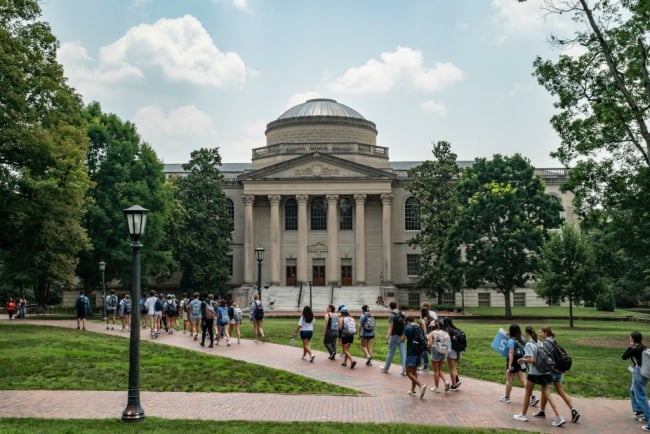You have /5 articles left.
Sign up for a free account or log in.

The University of North Carolina’s Chapel Hill campus on June 29, the day the Supreme Court struck down affirmative action in two cases, one of which was filed against that public institution.
Eros Hoagland/Getty Images
The past year brought seismic shifts to higher education, from the end of affirmative action to the escalating political battle over higher ed’s value and core mission.
In a year of heightened pressures, magnified public scrutiny and tightening purses, college admissions has been a lightning rod for many of the contradictions plaguing the sector, and the field is often tasked—fairly or unfairly—with resolving them.
“The admissions office really is the crucible for a lot of these changes, since it is where the rubber meets the road,” said David Hawkins, chief education and policy officer at the National Association for College Admission Counseling. “There’s always a set of conflicting demands, criticisms that higher education needs to become accessible for more people or that it’s too accessible for the wrong type of people. On the other hand, you have these mounting restrictions that suggest colleges have to do more with less.”
A Year of Change and Experimentation
A confluence of factors—not least the Supreme Court’s June decision to ban race-conscious admissions—prompted a flurry of innovation and experimentation in admission policies from public university systems and private institutions alike. New models like direct admission and guaranteed admission gained steam. And a general reckoning with selectivity and traditional admissions criteria—such as standardized testing—prompted many institutions to pursue a more holistic approach to populating their incoming classes.
The past year was also, in many ways, one of much-anticipated recovery. Enrollments finally began to climb back from their nosedive during the COVID-19 pandemic; four-year undergraduate, graduate and community college enrollments all increased significantly, nearly returning to pre-pandemic levels. So did international enrollment, with continued declines in Chinese students offset by a surge of interest from countries such as India and Nigeria, introducing a new set of priorities and expectations to the international recruitment sector.
But this fall’s admissions and enrollment landscape also showed dark clouds on an ever-encroaching horizon, as freshman enrollments dipped by more than 3 percent and the long-anticipated demographic cliff came into view.
As the enrollment challenges mount, they are likely to exacerbate what Hawkins sees as the increasingly blurred line between admissions officers and enrollment managers—the class builders and the salespeople.
“The transformation that has taken place over the last 20 to 30 years is that sales and marketing have been pushed to the forefront,” he said. “The job itself is changing. There’s still a big difference between most admissions officers and what we’ve seen in perhaps the for-profit sector at times with the high-pressure sales. But the demand on these folks to enroll students is immense.”
This year also saw the rollout of a new, simplified Free Application for Federal Student Aid, which promises to benefit more low-income students while reducing aid for many in the middle class. The process has vexed and exasperated many a financial aid and admissions officer, but the changes, which will take effect next year, are anxiously anticipated and largely welcome.
Admissions ‘Earthquake’ Tremors
The shadow looming large over both 2023 and 2024 is the Supreme Court’s ruling against race-conscious admissions. The full implications of the decision—from its impact on bridge programs and scholarships to the future of diversity in higher education—remain murky. They’re likely to crystallize further in the coming year as the first incoming classes built under the decision are announced.
Some fear that next year could spawn a feeding frenzy among conservative activists emboldened by the legal victory of Students for Fair Admissions founder Ed Blum, who may be lying in wait for an opportunity to further solidify the end of race consideration in determining access to higher education.
Art Coleman, founder of EducationCounsel LLC, a legal consulting firm, who has advised dozens of institutions in the wake of the ruling, doesn’t think so. He said the resetting of the legal landscape has probably made litigation less—not more—likely as institutions scramble to ensure compliance on the admissions front.
“I don’t expect any cases to rise to the SFFA level; I think we’re done with earthquakes for now,” he said. “I do think we will see some smattering of challenges on the legal front, but I think most of the realm of action we’re likely to see is going to be at the policy level, not the litigation level.”
Still, Coleman believes that complaints to the Office for Civil Rights will continue to multiply, as institutions race to implement new policies designed to conform to the ruling—or, as some may see it, to get around it. And when it comes to the decision’s potential impact on other college offices, such as financial aid, he said, all bets are off.
The ruling has also prompted a harder look at competitive colleges’ selectivity, increasing demands for more comprehensive accessibility to the most hallowed halls in higher ed.
Dozens of colleges ended their legacy admissions preferences, and others are under scrutiny from federal investigators and lawmakers. Race-neutral admissions policy changes continued to gain steam, especially test-optional policies. Admissions offices are also adjusting their recruitment practices, looking to refocus on lower-income ZIP codes and diversify their applicant pools. Even standard practices like early decision are under fire for catering to wealthier students.
“We’re now acutely aware of the equity implications of these practices,” Hawkins said. “They’re certainly less defensible than ever. Whether that will lead to actual change, we’ll see.”
Coleman added that it’s important not to overestimate the weight of the affirmative action decision on college admissions policies, many of which have been evolving since long before speculation on the ruling started to swirl.
“Even though it felt like a light switch flipped and you’ve got this dramatic change, the practical reality is that the underlying patterns and practices of institutions reflect a more nuanced evolution,” he said.
After the Storm, a ‘Moment of Reflection’
Whether or not the Supreme Court decision is the actual catalyst for wide-ranging transformation in admissions, it has undeniably focused a magnifying glass of public and political scrutiny on standard admissions practices, especially at more selective institutions. Coleman believes that’s precisely what makes 2024 an “ideal window for intense reflection and evaluation.”
“Now is a really good moment in time to think through, from soup to nuts, that array of factors that institutions are advancing to enroll a class,” he said.
Hawkins, like many in college admissions, is worried about the state of the profession as well. Turnover and burnout run rampant in admissions offices, and given the added political stressors and intensifying recruitment demands of the job, he has little confidence it is going to get easier.
But there is opportunity in hardship. As old assumptions and practices are destroyed, he hopes that the “crescendo of institutions” redesigning their admissions processes builds to a chorus.
“Despite the fact that 2023 was a dark year—and 2024 might be, too—this moment provides us with a great opportunity to make some fundamental changes and reshape how we go about this business,” he said. “This is such a long-overdue moment of reflection for us as a profession. We can’t continue to do the same thing over and over again and expect different results.”









